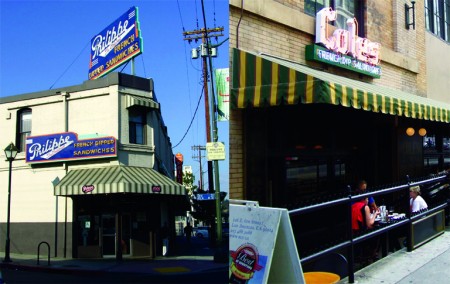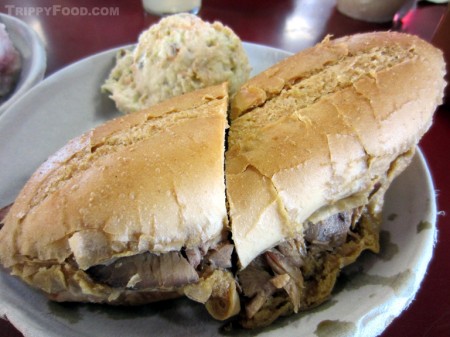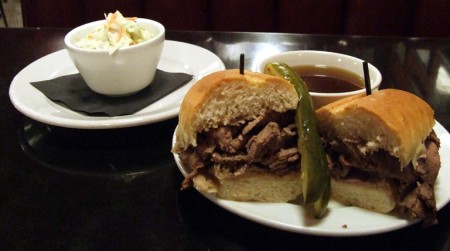French dip sandwiches
Philippe the Original and Cole’s Pacific Electric Buffet, Los Angeles, CA
No one doubts the French dip sandwich’s city of origin – it was born shortly after the turn of the 20th century, becoming one of Los Angeles’ signature dishes. But before you start feeling sorry for redheaded stepchildren French toast and French fries, understand that that the paternity of the French dip has been fraught with doubt and controversy since farther back than anyone still alive can remember. For those who have not visited L.A. and tried it, it is essentially a sliced roast beef sandwich (with pork, lamb, ham and turkey options added over the years) in a long roll that is dipped in au jus. It is usually served with as much or as little spicy “open-your-sinuses” mustard that you care to apply – this hellish concoction kicks Chinese mustard’s ass six ways from Sunday. The sandwich has evolved over the decades, with the roll originally having been dipped in beef gravy. You would think every restaurant in Los Angeles would be offering the dish, with either a nod to its creator or arguing over patent rights, but there are only two heavyweight contenders vying for the title of “Creator of The French Dip” sandwich – Philippe’s the Original, and Cole’s Pacific Electric Buffet. Both were first opened in 1908, and both claim to be the inventor of the tasty sandwich.
In this corner, Philippe the Original; the restaurant opened by French immigrant (take notes here) Philippe Mathieu in 1908 was originally on Alameda Avenue (without the sandwich as a menu item). Prior to his death in 1960, Mathieu stated that after moving to a new location in 1918, he was preparing a sandwich for a policeman in a hurry and when the roll fell into the gravy, the officer said he’d take it anyway. As the story goes, on the policeman’s next visit, he asked for the sandwich prepared the same way, and so a star was born. Mathieu sold the restaurant in 1927, and in 1951 the new owner moved Philippe’s to the current location on North Alameda Street in a building that formerly housed a machine shop. The decor is blue-collar factory deli – rows of plain counters line the main area where the food is ordered; the concrete slab floor is sprinkled liberally with sawdust. Patrons queue up in lines between the counters and order at the long deli case that lines the room; the line frequently stretches outside. The full menu is displayed on a blackboard-sized sign to the right of where you order, but specials and hot items are listed on signs behind the counter. Let the staff know what you want (although I recommend just asking for what they’re famous for), and any extras (they have delicious potato salad, pickled eggs, macaroni salad – you get the drill). Your sandwich will be dipped, but you have the option of requesting “double dipped”; dipping entails gently immersing the open face of the roll in the au jus prior to adding the meat. Don’t miss the opportunity to have what is most likely the only 9-cent cup [now 45 cents – Ed.] of coffee in town. When the time comes to pay for your selection, the server at the counter will push a little tray towards you with a pen. Don’t be offended – for sanitary purposes, your cash doesn’t “change hands”. You may have to wait for a seat at one of the communal counters, unless you’re lucky enough to snag a booth; try to feel good for the homeless guy who managed to grab the leftovers of the previous patrons of the adjoining counter. There’s plenty of nuclear death mustard on the counter (and no, it is the mustard that is that spicy – no horseradish, wasabi, habanero, etc); I would advise tasting a fork-end of the stuff before dousing your sandwich. Personally, I think it adds a nice kick, but just a fair word of warning – I did not see a medical aid station on the premises.
In this corner, Cole’s Pacific Electric Buffet; until 2007, Cole’s was renowned for being the oldest restaurant in Los Angeles in continuous operation until being closed for renovation and restoration, reopening in December of 2008. It is on the ground floor of the Pacific Electric Building, the former main terminal for the Pacific Electric Railway (Los Angeles’ famous Red Car line). Opened as a public house by Henry Cole (not a French name for those keeping score) in 1908, Cole’s was guaranteed clientele from the hustle and bustle of riders of the electric cars. Cole’s testimony regarding the origin of the sandwich is that sometime shortly after opening in 1908, a patron with sore gums requested his French bread (please take notes, I’m not repeating this) be dipped in the beef drippings to soften it up. After the recent restoration, the decor can best be described as ice cream parlor meets Victorian bordello; red-flocked wallpaper adorns the walls, and the restaurant is capped with a red tin ceiling. The white octagonal tile floors have some patches missing where counters or cabinets once stood and the seating options are wooden parlor chairs or plush vinyl 50’s style booths that look out of place with the turn-of-the-century decor. The restaurant is v-shaped, with the dining room on one arm and the fully stocked mahogany and glass Red Car Bar on the other. Cole’s is strictly sit-down dining; take any seat you like and the waitress will bring you a printed menu. There are two French dip options: the Big Dipper and the Little Dipper with the differences being the price and amount of meat. On my outing there I couldn’t resist ordering the “Cole’s Slaw” as a side; maybe I’m just not wowed by coleslaw, but theirs tasted like just about every other mayonnaise-based shredded cabbage and carrot salad I’ve ever had. One item (Atomic Pickles) sounded intriguing – I considered ordering them until my waitress informed me that two of them came with the sandwich. These tasted like someone took some dill spears and stuck them in a can of pickled jalapenos for a while, although there was an odd, sweet undertone to them as well. The sandwich was delivered to the table halved down the middle with a small cup of au jus on the side for dipping at the table. The meat seemed moister than Philippe’s (both are thoroughly cooked with no pink), but it may be because I ordered the Big Dipper, reducing the bread-to-meat ratio. Like Philippe’s, Cole’s also uses their own brand of deadly napalm mustard in the never ending French dip sandwich war, so caution is strongly advised.
The battle over exactly who invented the French dip sandwich has been raging for almost a century; it is doubtful the outcome will be decided in our lifetime, if ever. One thing is clear, this is a war where the diner is clearly the winner. Some of you may be looking to me for my opinion on who should emerge victorious, but I’m simply a war correspondent; I prefer to remain fair and balanced.
Philippe The Original
1001 North Alameda Street
Los Angeles, CA 90012-1803
GPS coordinates: 34°3’34.54″N 118°14’13.04″W
Cole’s Pacific Electric Buffet
118 E 6th St
Los Angeles, CA 90014-2006
GPS coordinates: 34° 2’41.23″N 118°14’58.25″W





Man, that sounds so great right now! I’ve only enjoyed the French dip at Philippe’s. Yet to try the Cole’s rendition. Had a cup of the 9 cent joe while I was at Philippe’s. The Great Recession never tasted so good!
Philippe’s all the way. Cole’s can be skipped and you won’t miss anything.
I think it’s worth a trip if for no other reason to see what the other side’s got – you should try Cole’s once, even if you’ll keep going back to Phillipe. I’ll stay impartial so the readers can make their own decision, but let’s just say that even though they’re both good, I do have a favorite and a pretty good idea who invented it…